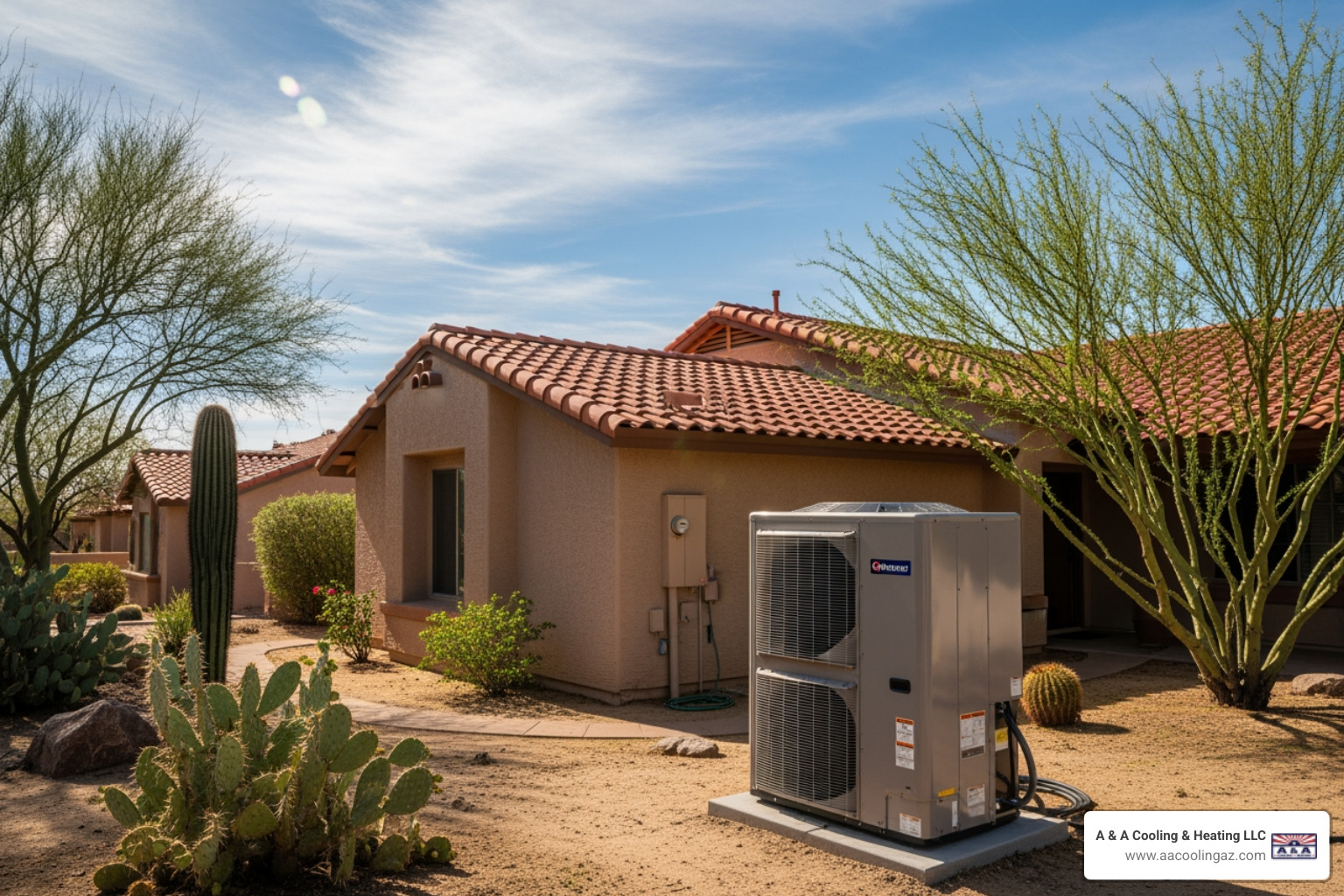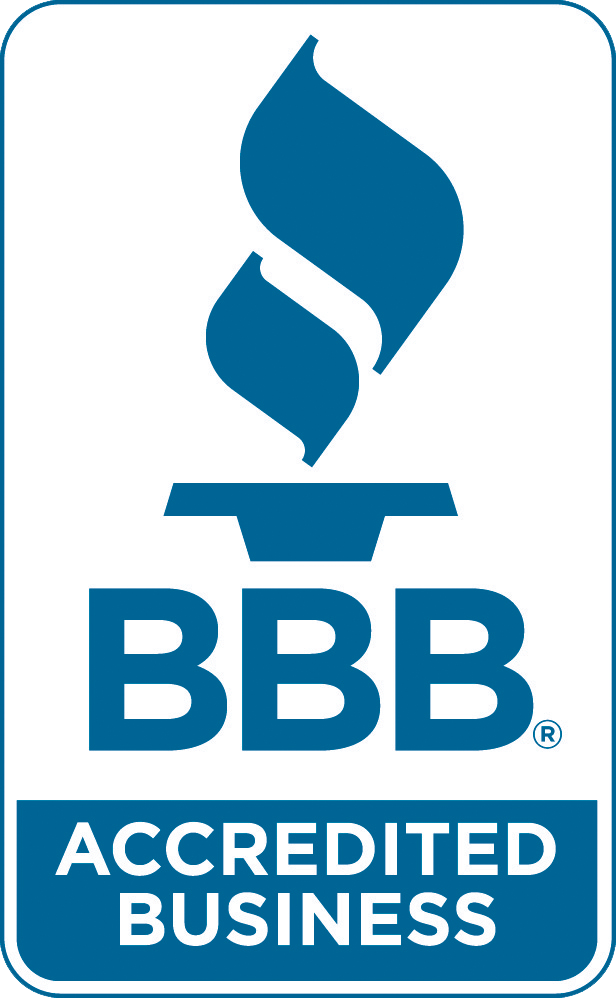Coil Catastrophe? Your Guide to AC Evaporator Coil Repair
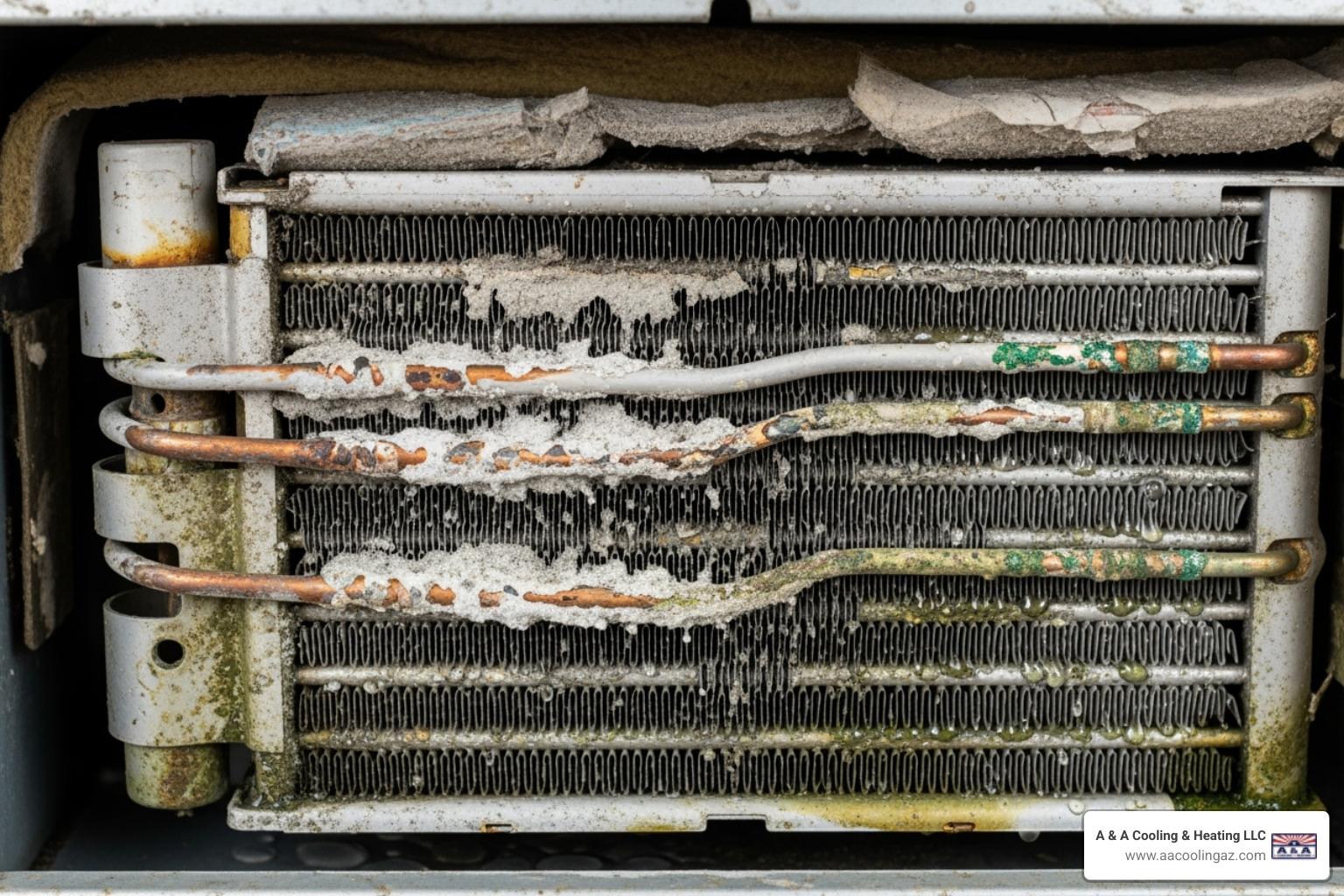
Your AC is On, But It's Still Hot? Understanding the Evaporator Coil
AC evaporator coil repair becomes necessary when your air conditioner runs constantly but fails to cool your home effectively. Here's what you need to know:
Quick Answer for AC Evaporator Coil Issues:
- Signs of Problems: Warm air from vents, ice buildup, water leaks, hissing sounds, higher energy use
- Common Causes: Refrigerant leaks, corrosion, dirty filters, clogged drain lines
- Repair vs. Replace: Systems under 10 years with minor leaks can often be repaired; older systems or multiple leaks typically need replacement
- Professional Required: EPA certification needed for refrigerant handling; DIY repairs risk further damage
If your air conditioner is running but your house isn't cooling off, the problem might be hiding inside your air handler. The evaporator coil—a critical component that absorbs heat from your indoor air—could be damaged, leaking, or frozen.
The evaporator coil works like a sponge for heat. As warm air passes over these copper coils filled with cold refrigerant, the coil absorbs the heat, leaving cool air behind. When this process breaks down due to leaks, corrosion, or blockages, your AC keeps running but stops cooling effectively.
Arizona's extreme heat makes evaporator coil problems especially frustrating. What starts as slightly warmer air can quickly become a complete cooling failure, leaving you uncomfortable and facing potentially significant repairs.
The good news? Understanding the warning signs and knowing when to call for professional help can prevent minor issues from becoming major system failures.
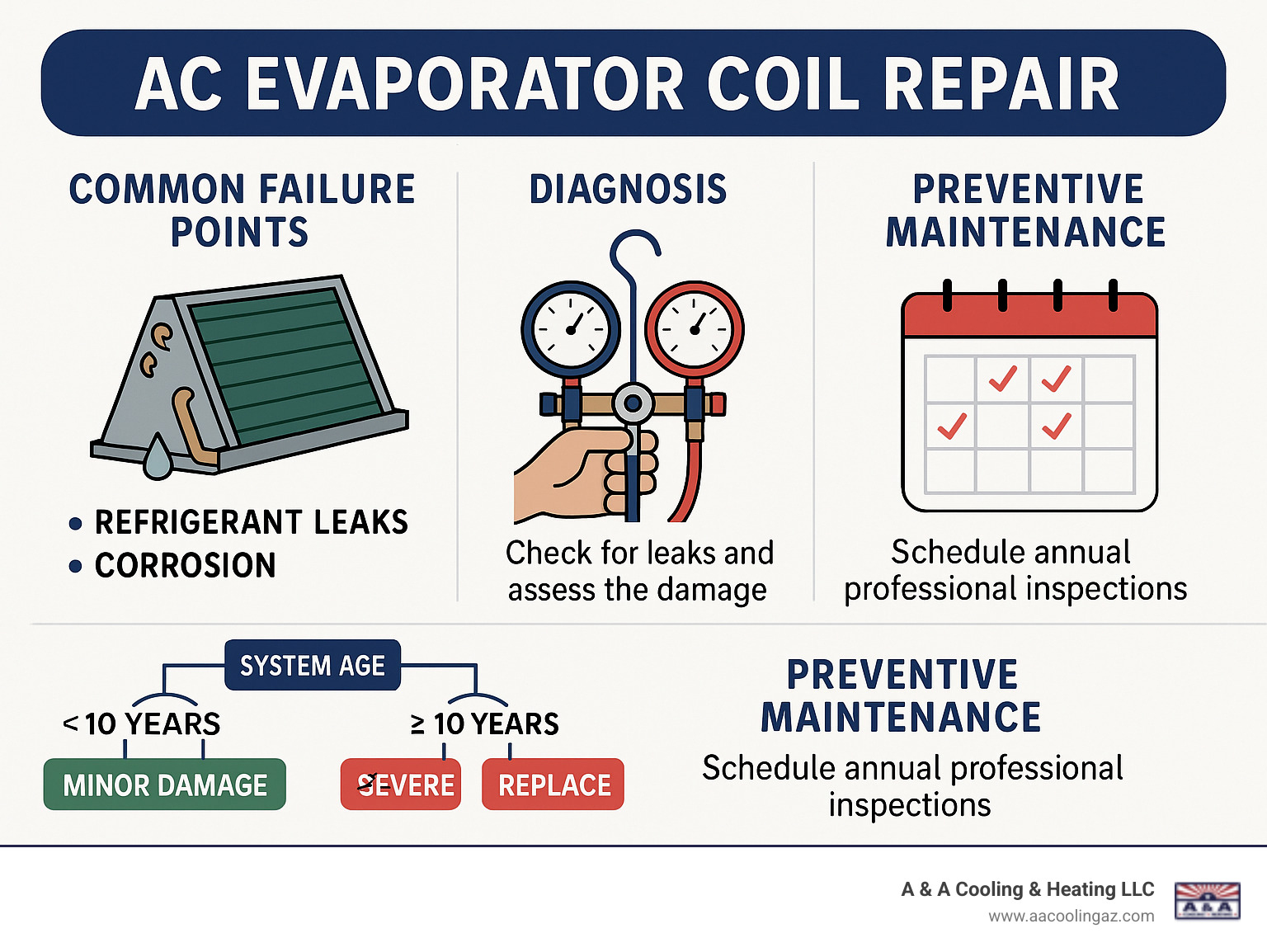
What is an AC Evaporator Coil?
At the heart of your air conditioning system's cooling power is the evaporator coil. This vital component, often nestled within your indoor air handler, is where the magic of heat absorption happens. Think of it as the cold sponge of your AC system.
As your home's warm, humid air is drawn into the air handler, it passes over the evaporator coil's chilled surfaces. Inside these coils, a substance called refrigerant flows at a very low temperature, rapidly absorbing heat from the passing air. This process also dehumidifies. As the warm air cools, it releases moisture, which condenses on the coil and drains away, leaving your home feeling cool and dry.
Once the refrigerant absorbs the heat, it transforms from a liquid into a gas and travels to the outdoor unit, where it releases the absorbed heat through the condenser coil. It's a continuous cycle of heat absorption indoors and heat release outdoors, effectively moving heat out of your home. This process relies on principles of thermodynamics and the Transportation of heat.
What Causes Evaporator Coils to Fail?
Even with regular maintenance, evaporator coils can fail. Understanding these common culprits can help you identify problems early.
One of the most prevalent causes is corrosion, which often results in tiny pinhole leaks. Formicary corrosion, for example, occurs when household organic compounds, water, and oxygen combine to create these holes. Volatile Organic Compounds (VOCs) from items like adhesives, air fresheners, and cleaning products can react with moisture on the coil, forming corrosive acids that slowly eat away at the metal.
Physical damage and vibrations can also lead to leaks. Over years of operation, constant vibrations can cause metal fatigue and lead to pinhole leaks, especially in older systems.
Dirt and debris buildup is another major enemy. If air filters aren't changed regularly, dust and debris accumulate on the coil. This buildup insulates the coil, preventing proper heat transfer and forcing the AC to work harder. It also traps moisture, promoting mold, bacteria, and further corrosion.
Finally, a clogged condensate line prevents moisture from draining away. Water can back up, overflow, and even cause the coil to freeze. Expanding ice can cause physical damage, creating new problems.
Signs Your Evaporator Coil Needs Professional Attention
Your air conditioner will signal when something is wrong; you just need to know what to look for. When your evaporator coil has problems, your AC will send out clear distress signals. Catching these warning signs early can mean the difference between a simple AC evaporator coil repair and a complete system replacement.
The most obvious red flag is warm air blowing from your vents. If you get lukewarm or warm air instead of a refreshing cool breeze, your evaporator coil isn't doing its job. This usually means the coil can't absorb heat properly, often because of a refrigerant leak.
Your energy consumption can also be a telltale sign. A struggling evaporator coil forces your AC to work overtime. The system keeps running, but never cools the house effectively. That extra runtime leads to higher energy use.
Water where it shouldn't be is another dead giveaway. If you spot puddles around your indoor unit, your evaporator coil is likely in distress. This happens when the coil freezes or condensate lines clog, causing water to overflow.
For a broader look at AC troubles, check out our guide on Common AC Repair Issues to see what else might be going on with your system.
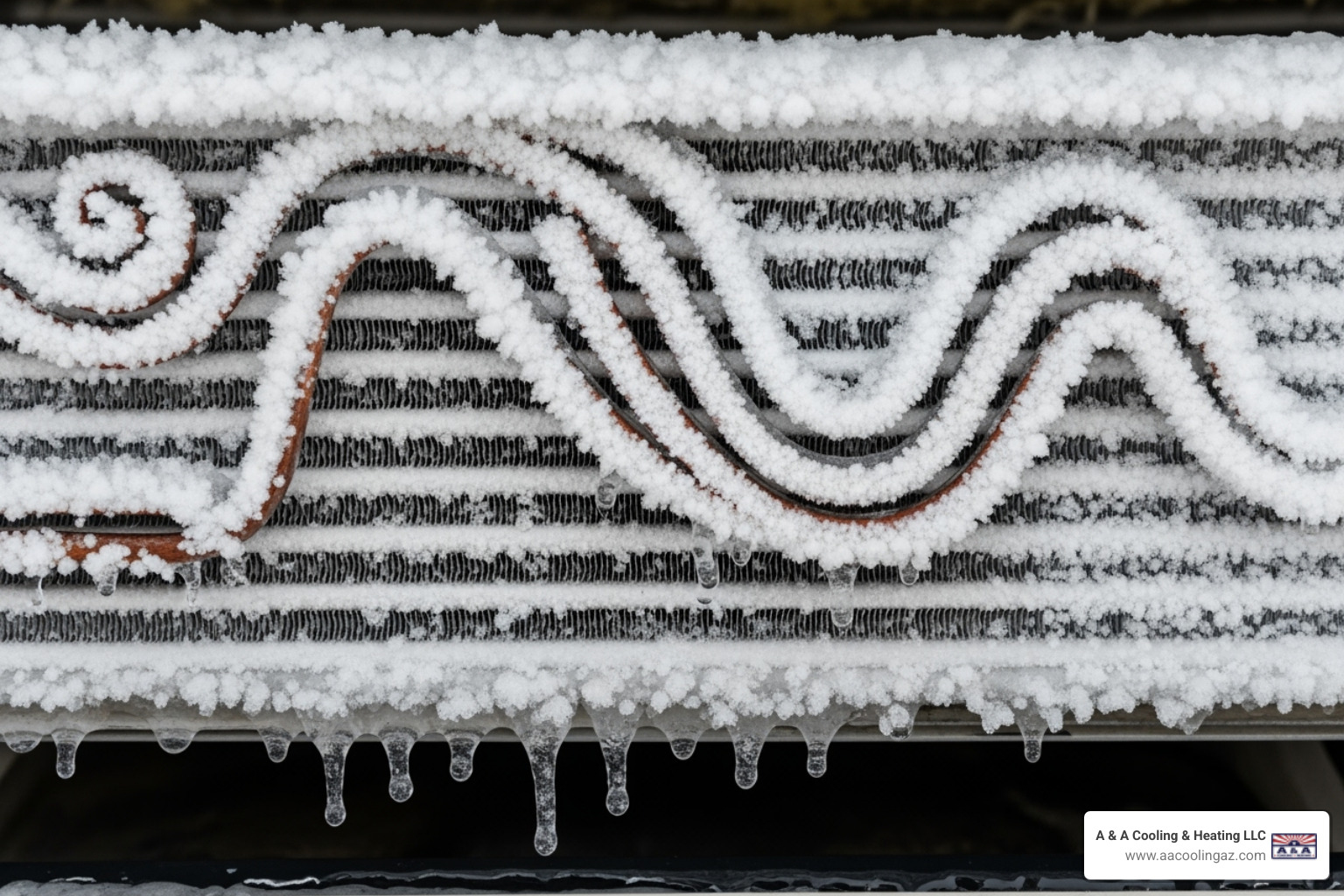
Top 5 Symptoms of a Leaking or Damaged Coil
When an evaporator coil starts to fail, it doesn't keep quiet. Here are the five most common ways your coil will let you know it needs professional attention:
- Hissing or Bubbling Noises - A subtle hissing sound indicates refrigerant escaping through a leak. Bubbling can mean air is getting into the system where it doesn't belong.
- AC Runs Constantly But Doesn't Cool - This is a frustrating symptom. Your AC sounds like it's working hard, but your house stays warm. It's a cycle of constant operation without results.
- Visible Ice or Frost on the Coil - Ice on your evaporator coil during summer is not normal. This usually means refrigerant is leaking (making the coil too cold) or airflow is restricted by a dirty filter or blocked vents.
- Puddles of Water Near the Indoor Unit - When the ice melts, it can overflow the drain pan if the condensate line is clogged. This leads to puddles, water damage, and mold.
- Unpleasant or Musty Odors - If your AC smells like a damp basement, mold or mildew has likely grown on your evaporator coil. This happens when moisture lingers due to poor drainage or a dirty coil.
If you notice several of these symptoms, it's time to call for help. Our guide on Signs Your Air Conditioner Needs Repair covers more warning signs.
The Problem with Frozen Coils
A frozen evaporator coil is a serious problem that can damage your entire AC system if ignored. When ice builds up, it blocks airflow, making the cooling problem worse. Your AC works harder but cools less.
Several things can cause a coil to freeze. The most common culprit is a dirty air filter. A clogged filter restricts warm air from flowing over the coil. Without enough warm air, the coil gets too cold and freezes the moisture in the air.
A dirty evaporator coil or blocked return vents can cause the same problem. If furniture or curtains cover your return vents, the system can't pull in enough warm air to keep the coil at the right temperature.
Sometimes the problem is more serious. Low refrigerant from a leak can cause the coil to freeze. When refrigerant levels drop, the pressure inside the coil changes, making it much colder than it should be. This is why ice often points to a refrigerant leak that needs professional attention.
The real danger is running your AC with a frozen coil. Your compressor—a critical part of your system—is designed for gaseous refrigerant. A frozen coil can send liquid refrigerant back to the compressor, causing severe damage or complete failure.
If you see ice on your evaporator coil, turn off your AC immediately and call a professional. Don't try to chip the ice away; you could damage the delicate fins. Let it thaw naturally or run the fan to help. For step-by-step instructions, see our guide on how to Resolve AC Frozen Coil Issues.
The Big Decision: Repair vs. Replacement
When your evaporator coil fails, you face a tricky decision: should you repair it or replace the whole system? The right answer isn't always obvious.
There's no one-size-fits-all solution. Your system's age, the extent of the damage, and its refrigerant type are all key factors in making the smartest choice for your home.
FeatureRepairing Evaporator CoilReplacing Evaporator Coil / Entire AC UnitScope & ImpactTypically limited to a single componentInvolves the entire indoor and/or outdoor unitSystem AgeIdeal for newer systems (under 10 years old)Recommended for older systems (10-15+ years old)Damage ExtentBest for minor, accessible, single pinhole leaksNecessary for multiple leaks, extensive corrosion, or severe damageRefrigerant TypeViable for modern R-410A systems; problematic for R-22Highly recommended for R-22 systems due to phase-out/availabilityWarrantyMay be covered if coil is still under warrantyNew components/system come with new warranties (often 10 years)EfficiencyMaintains existing efficiencyCan significantly improve energy efficiency (higher SEER)Long-Term ReliabilityShort-term fix, potential for future leaksMore reliable, extended lifespan of coolingCompatibilityEnsures existing system compatibilityMay require matching SEER ratings for optimal performance
Repairing is like getting stitches for a small cut, while replacement is like surgery for a serious condition. Both have their place, but timing and severity make all the difference.
When to Consider AC Evaporator Coil Repair
Sometimes, AC evaporator coil repair is the right call. A targeted repair can often restore comfort effectively.
Your system's age is the biggest factor. If your AC is under 10 years old, it likely has plenty of life left. A repair can keep it running smoothly for years. For these newer, more efficient systems, fixing them is a practical choice.
The type of damage matters too. A single, accessible pinhole leak can often be professionally patched. However, this is not a DIY job; our technicians use specialized tools to ensure a lasting repair.
Check your warranty status before making any decisions. Many manufacturers offer 5 to 10-year warranties on coils. If yours is covered, the parts may be included, simplifying the repair process.
Modern R-410A refrigerant systems are also great candidates for repair. This is the current standard, so parts and repairs are straightforward.
When to Replace the Coil or the Entire AC Unit
There comes a time when replacement simply makes more sense. Replacement is often the more reliable long-term solution.
Age tells the whole story in many cases. Once a system is 10-15 years old, it's nearing the end of its typical lifespan. A major repair at this age often signals that other components may fail soon. It can be more practical to consider a replacement.
Multiple leaks or extensive corrosion are clear signs that repair isn't worth it. These issues indicate the entire coil is failing. Fixing one leak often leads to another appearing soon after.
Mismatched SEER ratings create a tricky situation. Pairing a new, high-efficiency coil with an old, low-efficiency outdoor unit will compromise performance. The system's overall efficiency is limited by its weakest component.
R-22 refrigerant systems are almost always candidates for full replacement. This older refrigerant has been phased out due to environmental concerns, making it difficult to source.
System compatibility is crucial. If your furnace is also over 15 years old, replacing both units at once is often wise. This ensures all components are new, compatible, and work together seamlessly.
The decision ultimately comes down to ensuring long-term comfort and peace of mind. For more insights into common repair scenarios, take a look at our guide on the Top 5 Most Common AC Repairs.
The Professional Approach to AC Evaporator Coil Repair and Maintenance
When your evaporator coil needs attention, calling a professional is the only safe choice. AC evaporator coil repair requires specialized knowledge, tools, and safety protocols that only certified HVAC technicians have.
Your AC's evaporator coil is a delicate and complex component. Our technicians use specialized gauges, electronic leak detectors, and temperature sensors to accurately diagnose issues with system pressure, refrigerant levels, and overall performance.
The diagnostic process is comprehensive, including airflow assessments, electrical checks, and an examination of the entire refrigeration cycle. Once we pinpoint the problem, safe refrigerant handling is critical. Refrigerants require proper handling, recovery, and disposal procedures that only EPA-certified professionals can legally perform.
After any service, we conduct thorough system testing—verifying refrigerant charge, airflow, and safety controls—to ensure everything works correctly.
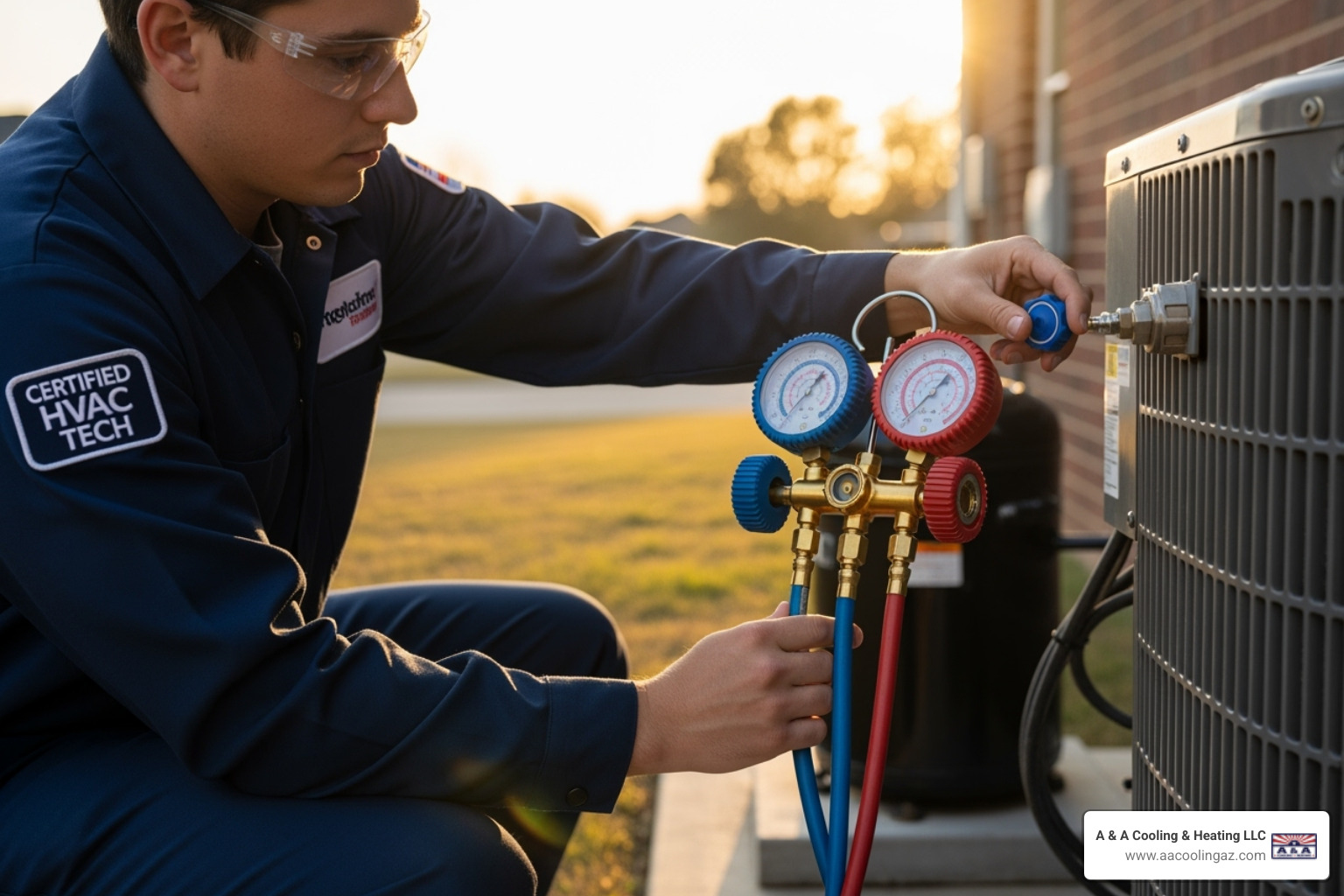
Why DIY Evaporator Coil Repair is Not Recommended
While DIY projects can be satisfying, evaporator coil repair should be left to the pros. Attempting it yourself can turn a manageable problem into a major setback.
First, there's the legal issue. Working with refrigerant requires specific EPA certification for refrigerant handling. This isn't just a suggestion—it's federal law. Handling refrigerant without this certification can lead to significant penalties and environmental violations.
Then there's the complexity. What seems like a simple leak could be a sign of widespread corrosion. Without proper diagnostic tools, you're guessing, which can lead to further complications.
The risk of further damage is very real. A simple mistake—a slip with a tool or an incorrect connection—can damage the coil beyond repair.
Don't forget about your warranty. Most manufacturers void warranties if an uncertified person works on the system, leaving you responsible for future repairs.
Safety hazards are also a major concern. Refrigerants can cause frostbite and respiratory issues if mishandled, and the system's electrical components pose a shock hazard. These are not risks worth taking.
How to Prevent Future Coil Problems
The best AC evaporator coil repair is the one you never need. Many coil problems can be prevented with consistent care.
Regular filter changes top our prevention list. A clean air filter is your coil's best friend, ensuring proper airflow and preventing dirt from coating its delicate fins. Change your filter every 1-3 months, or more often if you have pets or allergies.
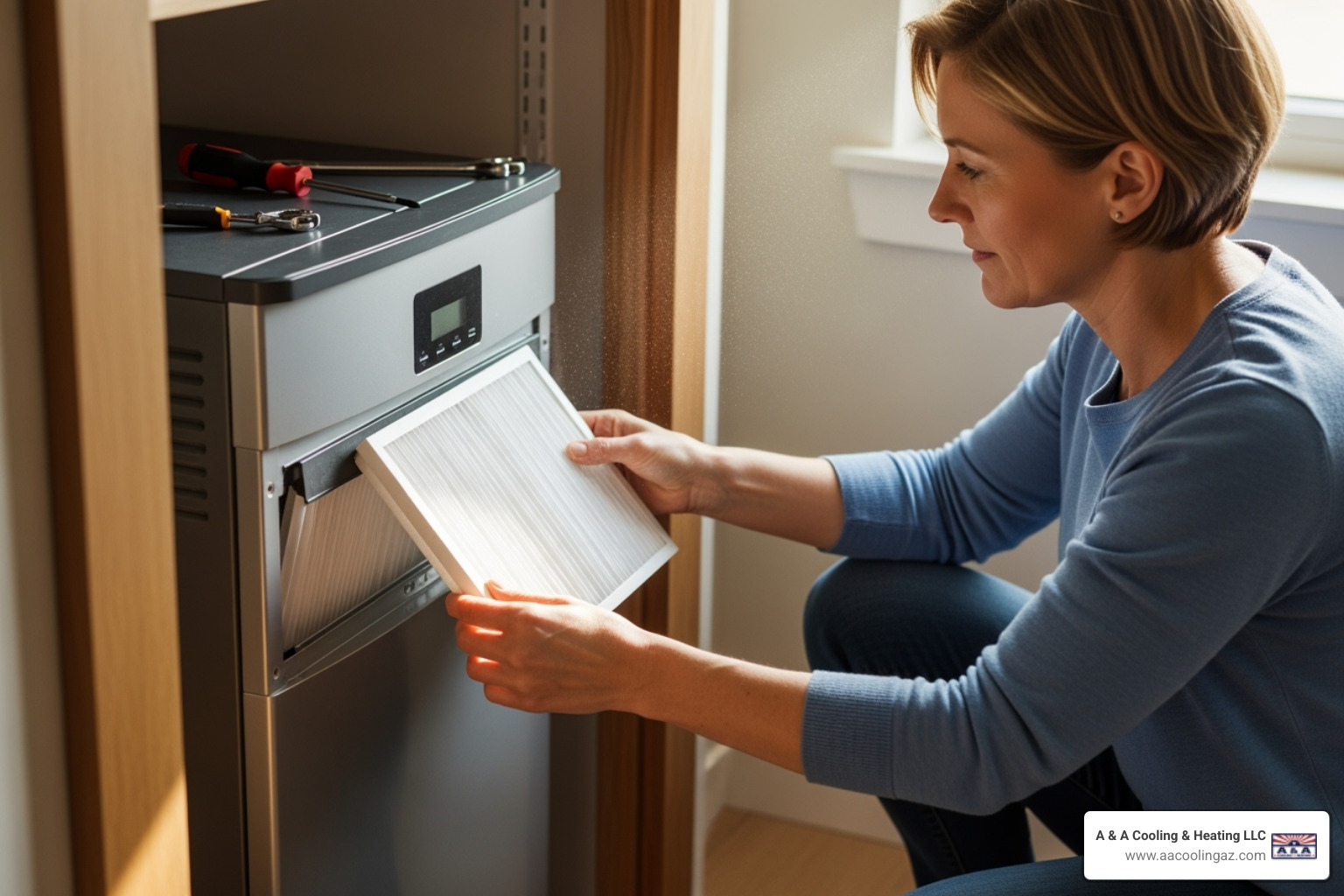
Annual professional maintenance is like an insurance policy for your coil. During these visits, we clean the coil, clear the drain line, and check refrigerant levels, catching small problems before they escalate. Prevention is the best strategy.
Keep your vents clear. It's amazing how often we find blocked return air vents. Furniture and curtains can restrict airflow enough to cause coil freezing. Periodically check that all vents have at least two feet of clearance.
Control indoor humidity to help prevent moisture-related problems. Arizona's dry climate helps, but during monsoon season, indoor humidity can spike. Consider a whole-house dehumidifier if humidity regularly exceeds 60%.
Reduce volatile organic compounds in your home to minimize formicary corrosion. Use low-VOC cleaning products, paints, and adhesives, and store household chemicals away from your indoor air handler.
These simple steps can extend your coil's lifespan significantly. For more specific guidance, check our article on AC Evaporator Coil Problems in Gold Canyon.
Frequently Asked Questions about Evaporator Coils
We often hear the same questions about evaporator coils. Let's tackle the most common ones.
How long should an evaporator coil last?
A well-maintained evaporator coil should last 10 to 15 years, about the same as the entire AC system. Some can last even longer.
However, this lifespan depends on regular maintenance. Consistently changing air filters, scheduling annual tune-ups, and keeping vents clear are key. Your coil will thank you with years of reliable service.
Arizona's environment—intense heat, humidity, and dust—can accelerate wear. Combined with household volatile organic compounds, this can lead to premature failure if maintenance is neglected.
The bottom line: proper maintenance extends your coil's life, while neglect shortens it.
Can a small evaporator coil leak be fixed?
This is a complicated question. Technically, a skilled technician can sometimes patch a small, accessible pinhole leak.
However, finding every tiny leak is difficult. Coils are intricate, and what appears to be one leak may be one of many. If corrosion caused the first leak, it's likely creating more. Fixing one hole today may only lead to more leaks tomorrow.
For this reason, replacement is usually the more reliable long-term solution than a temporary patch. It's the honest answer that prevents future headaches.
What happens if I ignore a damaged evaporator coil?
Ignoring a damaged evaporator coil is like ignoring a small roof leak: the problem will only get worse and the damage will spread.
First, your energy consumption will skyrocket. A compromised coil can't absorb heat properly, so your AC runs constantly with little result.
The real danger is damage to your compressor—the heart of your AC system. Leaking refrigerant causes the compressor to work overtime, which can lead to overheating and complete failure. Compressor replacement is one of the most significant repairs you can face.
Eventually, the strain can cause a complete system failure, turning a small coil issue into a major breakdown, leaving you sweltering in the Arizona heat.
Refrigerant leaks also harm the environment and can pose health risks. The moral of the story is to address coil problems quickly to prevent bigger headaches later.
Get Your Cool Back: Next Steps for a Healthy AC
A failing evaporator coil can be overwhelming, especially during an Arizona summer. You don't have to tackle it alone. At A & A Cooling & Heating LLC, we've helped Apache Junction families stay cool since 1976 and know how to restore your AC's performance.
The first step is an expert diagnosis. Our certified technicians use specialized equipment to pinpoint the exact problem, whether it's a repairable leak, widespread corrosion requiring replacement, or a frozen coil from restricted airflow. We'll give you a straightforward assessment.
Once we identify the problem, we'll explain your options. Whether it's a targeted AC evaporator coil repair for a newer system or a strategic replacement for an older unit, we'll help you make the right decision for your home.
Our goal is to provide long-term solutions for your comfort. We believe in honest assessments. If your older system needs a new coil, we'll discuss if that's the best path forward or if upgrading to a more efficient system offers better long-term reliability.
Year-round comfort is what we're all about. Our Cool Club maintenance plan helps prevent these problems. Regular maintenance catches issues early, maintains efficiency, and extends the life of your evaporator coil.
We understand that HVAC repairs can be a significant undertaking. Our team is here to guide you through the process and ensure you have a clear understanding of the work needed.
Don't let a coil problem leave you sweating through another Arizona summer. Our experienced team is ready to restore your home's comfort with the reliable service we've provided for nearly five decades.
For expert help with all your heating and cooling needs, schedule your AC Repair in Gilbert, AZ today. We're here to get your cool back!






